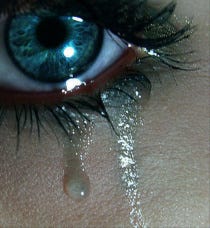The science of crying and of making eye contact
This post is a little repository of information that Ali finds note-worthy, for a Saturday.

Picture from here.
I’ve done a little more than my quota of crying lately (ladies on average cry about five times a month, apparently), just because that is the season I am in. But I was reading a little article in Frankie Magazine Vol 50, by Jo Walker, on the science of crying, which provides the comfort of explaining that all the sniffling is good for something. Here is a piece of it:
There are three kinds of crying: basal tears that lubricate and protect the eye, reflex tears that flush our irritants like smoke or onion vapours, and emotional tears triggered by anything from weepie films and ads with puppies to pain, grief and despair. Of all life forms, only humans produce emotional tears. Streaked mascara and red-ringed eyes are what separates us from the animals [but human babies don’t cry emotional tears until around seven months old, from later in the article].
Having a good cry can be an emotional release, and research shows it’s a chemical one too. When you’re stressed your body produces substances like prolactin and adrenocorticotrophin, both of which show up in large doses in emotional tears. So crying is your body’s blubbery, damp way of dumping stress hormones where they can’t cause harm: your cheeks, nose and sleeve. Turning on the waterworks arouses the sympathetic nervous system (that’s your fight-or-flight responses) and sedates the parasympathetic nervous system (your rest-and-digest activities) – but the second is activated for a longer time. Which explains why you can feel so calm after bawling your eyes out. Your body is basically forcing you to chill.
...
And the biggest triggers for crying? According to the Dutch [some of the research in the article was done out of Tilburg University in the Netherlands] they are feelings of rejection or inadequacy, or fear of being separated from a loved one.
Then, on a slightly related (well, it’s not actually, but just run with it) topic, the other day I read a fascinating little post over at A Cup of Jo, about why children think they are invisible when they cover their eyes. This is what some Cambridge researchers discovered (via Jo):
In both studies so far, when the children thought they were invisible by virtue of their eyes being covered, they nonetheless agreed that their head and their body were visible. They seemed to be making a distinction between their 'self' that was hidden, and their body, which was still visible. Taken together with the fact that it was the concealment of the eyes that seemed to be the crucial factor for feeling hidden, the researchers wondered if their invisibility beliefs were based around the idea that there must be eye contact between two people—a meeting of gazes—for them to see each other (or at least, to see their 'selves').
Another paragraph from that research notes:
"... it would seem that children apply the principle of joint attention to the self and assume that for somebody to be perceived, experience must be shared and mutually known to be shared, as it is when two pairs of eyes meet," the researchers said.
That is all very interesting, is it not.

